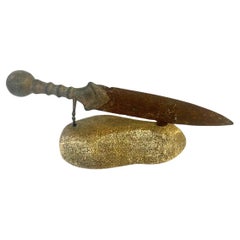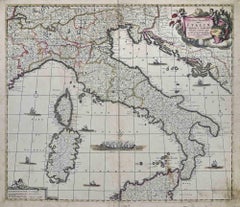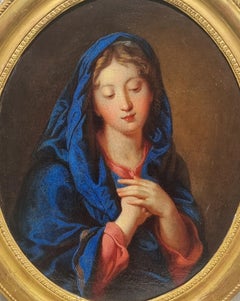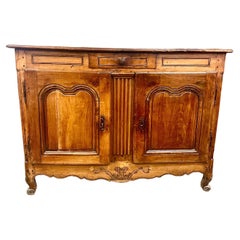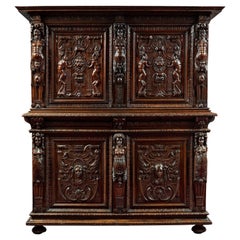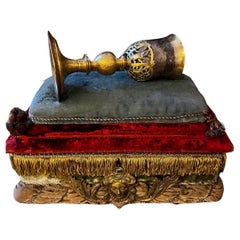France
to
344
3,528
28,315
17,843
50,755
39,880
25,156
21,730
16,541
10,506
7,715
6,770
6,486
4,721
4,378
3,913
3,528
2,927
2,828
2,757
2,674
2,194
2,192
1,674
1,145
926
889
771
747
722
705
592
522
502
473
366
357
288
176
165
151
139
123
102
96
83
60
50
48
47
43
41
35
35
29
27
26
14
13
12
10
8
7
7
3
3
73
66
50
40
28
Period: 18th Century and Earlier
Period: Late 18th Century
Antique Roman Gladiator Short Sword 1.AD with Bronze Teardrop Terminal Belt
Located in Doha, QA
This Roman Gladiator short sword is an absolutely outstanding and unique example of an ancient Roman Pompeian Gladius Sword from 1. AD. There were three ty...
Category
15th Century and Earlier Italian Classical Roman Antique France
Materials
Bronze, Iron
Novissima et Accuratissima Totius.. - Etching by Frederick de Wit - 1680ca
By Frederick de Wit
Located in Roma, IT
This double-page etching with contemporary coloring, entitled Novissima et Accuratissima totius Italiae, Corsicae et Sardiniae, was realized by the cartographer Frederick de Wit for ...
Category
1680s Modern France
Materials
Etching
Classical 18th French Religious Painting Virgin Annunciation After DE LA FOSSE
Located in PARIS, FR
French school of the 18th century
After Charles de LA FOSSE (1636 - 1716)
The Virgin of the Annunciation
Oil on canvas
46 x 37.5 cm (59 x 51 cm with the frame)
Beautiful oval frame i...
Category
18th Century French School France
Materials
Oil
18th Century French Provincial Walnut Buffet
Located in LA CIOTAT, FR
A handsome 18th century French Provincial buffet, or sideboard, in mellow and beautifully aged walnut. Opening with a central frieze drawer and two large, lockable cupboard...
Category
18th Century French Louis XV Antique France
Materials
Walnut
Renaissance Cabinet from Burgundy or Lyon Region
Located in Saint-Ouen, FR
Renaissance cabinet from Burgundy Or Lyon Region
Origin : Burgundy Or Lyon, France
Period : Second Half 16th Century, C. 1580
Height : 209cm
Length : 184cm
Depth : 71cm
Good condition
Walnut wood, original keys and keyholes
Around the middle of the 16th century the conception and ornamentation of French furniture evolves. The start of major building projects, such as the castle of Fontainebleau, gives artists a new impulse. Inventive and rich formulas are developed there, before spreading to all of Europe thanks to engravings and printed leaflets. Furthermore, Italian artists working on such construction sites bring French artists and patrons a renewed taste for the Antique.
Regarding the art of furnitures, the most complex scenes and figures are drawn from illustrated books, ornament and emblem compendiums and engraving compilations. Rather than copying those images the artisans feed their inspiration and decline the motifs in numerous variations.
The ornamental grammar marks a return to the Antique : palm leaf, acanthus, egg-and-dart, greek, scroll, fluted pilaster… It is in Primaticcio’s and Il Rosso’s stuccos made around 1540-1550 that we have to look for the origin of leather cut-outs, masks, chimaeras, harpies, sheathed figures, fruit and flower garlands that soon enrich every pieces of French furniture.
The structure of the pieces of furniture also evolve thanks to the re discovery of Antique architectures, rigorously used as a model.
This cabinet presents an imposing structure and a rich and original decor exemplifying the production of the late 16th century, infused with Italian, Antique and Fontainebleau influences.
It stands on a moulded base ornate with palm leaves. It opens with four door-leaves and two drawers in the belt. Six whimsical terms divide the facade.
The lower body is horizontally divided by three sheathed female terms. The two standing on the lateral posts are topped with fruits while the body is covered by acanthus leaves carved with precision, belted at the waist. The term standing on the central door-jamb is crowned with laurel leaves and is draped in the Antique fashion. A wincing mask hides the key hole.
The two door-leaves are centred by a beautiful mask carved in a strong relief. They wear stylised feathered headdress and are set on draperies. Straps, leather scrolls, acanthus leaves and a shell are spread around the masks. The recessed panels are secured in frames ornate with acanthus leaves.
The belt is flanked by two large mouldings enriched with variations of acanthus leaves. The drawers are carved with choux bourguignons and palm leaf motifs minutely executed. The consoles between each drawer bear tormented wincing masks, showing horns as if they were fauns or imps.
The upper body is framed by two male terms characterised by a strong and nervous musculature, their manhood hidden by drapes secured thanks to a winged lion head. The term on the left appears to be younger and is wincing while the one on the right has a beard. The central female term brings contrast with her youth and sensuality. As it is the case on the lower body, the key hole is hidden behind the mouth of a faun’s mask placed on the drapes barely covering the intimacy of the caryatid.
The panels of the upper body present an idealised architecture comprising pilasters and sinuous broken pediments. The pilasters are flanked by two satyrs with goat legs. In the centre appears an important lion mask.
The terms of the upper body support the cornice. The entablature carries palm leaves and roses alternating as well as an egg-and-dart frieze. The cornice is adorned with acanthus motifs.
On the sides, the carving is executed flat. A central rose is surrounded by scrolls, flowers and choux bourguignons.
We can admire the variety of the elements employed. The artist vary with great genius many different ornamental motifs : palm leaf, egg-and-dart, laurel leaf, roses, scrolls … But the artist went even further as each profile and each face is individualised and presents different features. You can take a look at the faces of the satyrs flanking the upper body’s panels. The talent of the artist is undeniable.
It makes no doubt the patron who commissioned this cabinet was an aesthete looking for the greatest quality.
The artist who authored this cabinet had a great mastery of composition both in the general design and in the individual panels. They probably drew inspiration from engravings and drawings made especially for the making of this piece of furniture or not. They seem to be familiar with the style of Jacques Androuet du Cerceau. Indeed, we can find in Du Cerceau’s engravings the same juxtapositions of leather cut-outs, masks and fruits. The terms and caryatids used on the facade could very well be inspired by his work as well. The cabinet-maker was also undoubtedly observant of Hugues Sambin, the most famous cabinet-maker and sculptor in the Burgundy of the time. Like Du Cerceau, Sambin left an important ensemble of models particularly useful for the design of cabinets. His publication De l’Oeuvre de la diversité des termes dont on use en architecture (1572) was an essential book for every artisan.
All the motifs testify of the artisan’s high knowledge of forms as well as the precision of their tools : super imposition of ornamental elements, foliages, architectural cut-outs, flat and high reliefs alternating, palm leaves inscribed in circular spaces, wincing faces. It is also a testimony of the artisan’s familiarity with Italian and Fontainebleau productions.
Because of the proficiency of the cabinet-maker in so many different models, this cabinet truly is a master-piece authored by the hand of an authentic master.
The generous carvings executed with great rigour and virtuosity evoke an origin close to Burgundy and Lyon workshops. This cabinet was made by a master of the region during the Second French Renaissance.
Literature
BOCCADOR Jacqueline, Le mobilier français du Moyen-Âge à la Renaissance, Édition d’art Morelle Mayot, 1996
BOS Agnès (dir.), Mobilier du Moyen âge et de la Renaissance, La collection du musée du Louvre, Louvre éditions...
Category
16th Century Renaissance Antique France
Materials
Walnut
Antique 16th Century German (Augsburg) parcel-gilt Silver-Gold Chalice/Goblet
Located in Doha, QA
This is an absolutely exquisite rare Cooper-gilt ,silver-gold and three Sterling Silver angels Chalice originated from Augsburg (Germany ) in th...
Category
16th Century German Renaissance Antique France
Materials
Gold, Silver, Copper
18th Century French Fruitwood Commode
Located in LA CIOTAT, FR
A magnificent 18th century French Louis XV Epoque serpentine fruitwood commode chest of four drawers, standing on elegantly carved feet. Distributed over three rows, each moulded dra...
Category
18th Century French Louis XV Antique France
Materials
Bronze
French 18th Century Marble-Top Louis XVI Console Table
Located in Buisson, FR
Beautiful marble-top Louis XVI console table. Wonderful carvings and great patina. Original marble top.
France, circa 1770-1889. Weathered and small losses.
More photo's are availab...
Category
18th Century French Louis XVI Antique France
Materials
Marble
Le Chat Sauvage - Etching by Louis Legrand - 1771
By Louis Legrand
Located in Roma, IT
Le Chat Sauvage is an etching realized in 1771 by Louis Legrand (1723-1807).
The Artwork is depicted through confident strokes in aa well balanced composition.
Good conditions.
Category
1770s Modern France
Materials
Etching
Rare Antik Judaic Kiddush Cup Medieval Period
Located in Beuzevillette, FR
Very rare small Judaic cup from medieval period used for the Kiddush ceremony and also probably for circumcision. This chiseled bronze cup is decorated on its belt, with Hebrew characters. The back of the cup is decorated with the Star of David. The whole has a beautiful old patina.
This object with certain oriental influences, probably comes from medieval Spain...
Category
15th Century and Earlier Spanish Islamic Antique France
Materials
Bronze
Set of Four Italian Walnut Savonarola Armchairs
Located in Saint-Ouen, FR
Set of four Italian walnut Savonarola armchairs
ORIGIN : FLORENCE, ITALY
PERIOD : LATE 15TH CENTURY - EARLY 16TH CENTURY
Measures: height : 102 cm 40.15 inches, height : 93 cm 36.61 inches
length : 68 cm 26.77 inches, length : 68 cm 26.77 inches
depth : 55 cm 21.65 inches, depth : 50 cm 19.68 inches
Walnut
Very good condition
This movable Italian seat from the late 15th century descents from the roman curule seat. It took the name of sedia Savonarola...
Category
16th Century Italian Renaissance Antique France
Materials
Walnut
18th Century, Italian Carved Giltwood Baroque Mirror
Located in Buisson, FR
Beautiful carved giltwood baroque mirror, Italy, circa 1750. Weathered, small losses and old repairs.
Category
18th Century Italian Baroque Antique France
Materials
Wood
Baldaquin -large Four-poster Bed In Patinated Steel, Late 18th Early 19th Centur
Located in MARSEILLE, FR
Baldaquin -large four-poster bed in patinated steel, topped with a large canopy.
The sides are equipped with a system of "rods" for draperies.
Signed with initials W.C.H
Wear a...
Category
Late 18th Century European Louis XVI Antique France
Materials
Steel
Spanish 17th/ 18th Century Hand Carved Wooden Baroque Angel
Located in Buisson, FR
Wonderful hand carved standing Baroque angel figure. Unique period piece with its original paint .
Spain, circa 1650-1750
Weathered. .
Measurement here below includes the wooden ba...
Category
17th Century Spanish Baroque Antique France
Materials
Wood
18th Century Large White Marble Mortar
Located in LA CIOTAT, FR
An 18th century mortar made from hand-carved beautifully veined Carrara marble. Fashioned in the traditional style, with four shaped corners and a deep bowl, this would once have bee...
Category
18th Century French Antique France
Materials
Marble
Antique French Louis XVI Pair Of Armchair, Gilded Wood, 18th Century
Located in Senonches, Centre-Val de Loire
Rare pair of Louis XVI period armchairs in gilded wood with original double cane armrests.
The fluted turned wood legs and hand-carved details are the result of remarkable craftsman...
Category
Late 18th Century French Louis XVI Antique France
Materials
Linen, Oak
Antique Portrait Antonio de Leyva Prince of Ascoli (1480-1536) Oil on Canvas
Located in Doha, QA
Antonio de Leyva, Duke of Terranova, Prince of Ascoli (1480–1536) was a Spanish general during the Italian Wars. During the Italian War of 1521, he commanded Pavia during the siege o...
Category
16th Century Italian Renaissance Antique France
Materials
Canvas
Louis XV Desk With Steps In Carved Walnut – France, Late 18th Century
Located in PARIS, FR
Crafted in France at the end of the 18th century, this exquisite « bureau à gradin » embodies the elegance and refinement of the Louis XV style. Its beautifully sculpted walnut showc...
Category
18th Century French Louis XV Antique France
Materials
Walnut
Dancing Couple
Located in Paris, Île-de-France
Attributed to Charles-Nicolas Cochin the Younger (Paris, 1715 – 1790)
Dancing Couple
Circa 1765–1770
Red chalk on cream paper; verso in black and red chalk
34 × 21 cm
Provenance:
...
Category
Late 18th Century Old Masters France
Materials
Chalk
Small 18th Century, Italian Handcarved Silver Gilt Baroque Mirror
Located in Buisson, FR
Beautiful small handcarved wooden Baroque mirror, with its original weathered silver/gilding.
Italy, circa 1750. Weathered
H:26,5cm W:23cm D:3cm
Category
18th Century Italian Baroque Antique France
Materials
Wood
A Mounted 17th Century Folk Art Brass Bassinoire Cover from France
Located in Buisson, FR
This pierced brass decorative element from France was originally the cover of a bassinoire from the 1600s. A bassinoire is a device where hot coals are inserted into a vented recept...
Category
17th Century French Folk Art Antique France
Materials
Brass
Large 18th Century, Italian Carved Wooden Wing of a Baroque Angel
Located in Buisson, FR
Beautiful large Baroque angel-wing with its original color and gilding. Extremely rare to find in this size.
Very decorative item placed on a wooden base.
Italy, circa 1750. Weathere...
Category
18th Century Italian Baroque Antique France
Materials
Wood
Italian 18th Century Gilded Paper Mache Dove/ Holy Spirit
Located in Buisson, FR
Amazing gilded paper mache dove/ Holy spirit. Beautiful detailed.
The Dove is a symbol for the Holy Spirit inspired by Jesus’s baptism. The dove has been used among many Christian de...
Category
18th Century Italian Baroque Antique France
Materials
Paper
Antique French Louis XVI 18th Century Gold Gilded Picture Frame
Located in Doha, QA
Magnificent 18th century French hand carved and gold gilded frame. An incredible detailed work. The frame looks Royal and luxurious. Dimensions of the interior painting size to fit a...
Category
18th Century French Baroque Antique France
Materials
Gold
Early 17th Century School of Peter Paul Rubens “The Holy Family” Oil on Canvas
Located in Doha, QA
This is an absolutely incredible early 17th century oil on canvas painting representing Holy Family-Virgin Mary, St.Joseph, St. Elisabeth, John the Baptist and Baby Jesus. Sir Peter ...
Category
Early 17th Century Italian Baroque Antique France
Materials
Canvas
18th Century French Green Glazed Walnut Oil Jar
Located in LA CIOTAT, FR
This is a fabulous example of a large 18th century French walnut oil jar, with three decorative handles and short pouring spout. Retaining its original dusky-green glaze, the jar is ...
Category
18th Century French Antique France
Materials
Earthenware, Terracotta
17th-18th Century Italian Hand carved Wooden Reliquary Bust of a Saint
Located in Buisson, FR
Spectacular and very decorative piece. Large hand carved wooden reliquary bust of a saint. Beautiful weathered color and gilding. Small losses/Old repairs and without the relics. Ita...
Category
18th Century Italian Baroque Antique France
Materials
Wood
16th Century Ming Dynasty, Blue Design Set Of Three Plates On Stands, China
Located in New York, NY
16th century Chinese Ming Dynasty set of three hand painted plates on stands.
Plate sizes. 7 x. 14.5 7. x. 14. 7. x. 13.5
Stands measure. 5. x. 3. and. 4. x. 3
Category
16th Century Chinese Antique France
Materials
Ceramic
Antique reliquary locket pendant 18th century in 18k gold
Located in PARIS, FR
Antique reliquary locket pendant 18th century in 18 karat rose gold. On one side, the pendant is decorated with a miniature on vellum depicting Saint ...
Category
1790s Italian Georgian Antique France
Materials
18k Gold
Statue sculpture life size antique old Roman Greek stone reclaimed carving decor
Located in Costa Mesa, CA
Antique statue life sized Roman Greek natural stone old sculpture.
The antique statue displayed in this Ad is one of 12 reclaimed life sized limestone s...
Category
Early 18th Century French Rustic Antique France
Materials
Limestone
Saint Florian
Located in Saint-Ouen, FR
SAINT FLORIAN
ORIGIN: SOUTH GERMANY, SWABIA
PERIOD: END OF THE 15th CENTURY
Height : 100,5 cm
Width : 34 cm
Depth : 17 cm
Polychromed lime wood
Good state of conservation
Sin...
Category
15th Century and Earlier German Gothic Antique France
Materials
Wood
Small 17th Century, French Coffer or Box in Leather
Located in Buisson, FR
Extremely old box that is covered with leather and metal decorations.
Rare find.
France, circa 1600-1700
Weathered and some losses.
Category
17th Century French Antique France
Materials
Leather, Wood
Spanish console in massive walnut waxed and iron legs late XVIIth
Located in PARIS, FR
Crafted in the 17th century, this Spanish console table showcases the timeless elegance of waxed walnut. The rich, warm tones of the wood highlight its fine grain, giving the piece d...
Category
Late 17th Century Spanish Spanish Colonial Antique France
Materials
Wrought Iron
English Welsh Buffet in Oak XVIIIth Century - English antiques - United Kingdom
Located in Beuzevillette, FR
18th century oak sideboard opening with two doors with panels in the lower part with wooden buttons and three belt drawers with brass catches. The upper part of the cupboard, set back slightly, has three molded doors and a projecting cornice surmounted by a frieze in genoese and finished at the corners by two small balls...
Category
18th Century Welsh Antique France
Materials
Wood
Oratoire D.João V / D.José sur pied Bois sculpté, polychrome, marbré et doré
By A. Santos, Portugal 1
Located in PARIS, FR
Oratoire D.João V / D.José sur pied
Bois sculpté, polychrome, marbré et doré
Portes intérieures à panneaux peints représentant deux anges avec les instruments de la Passion du Chris...
Category
18th Century Portuguese Rococo Antique France
Materials
Giltwood
Important Renaissance Cabinet from Lyon 'France' with a Decor of Perspectives
Located in Saint-Ouen, FR
As soon as 1540 France's second Renaissance is in the making, intimately linked to the rediscovery of the Antique world. The development of the printing and engraving industry allows the spread of artworks and models in many cities and countries. The Italian influence can be perceived in every artistic field. While the French king entrust the most talented Italian artists with major projects such as Il Rosso or Primaticcio in Fontainebleau, French artists also travel to Italy to form themselves to this new style. In Italy they get acquainted with the work of Leo Battista Alberti the first to theorize perspective (De Pictura, 1435-36) and architecture (De re oedificatoria, 1541). Those two publications would have a revolutionary impact on arts.
Furniture is marked by the work of the most famous Italian architects of the time as well as French architects. Indeed Philibert de l'Orme competes with Alberti and by the end of his life publishes several treaties including one devoted to a theory of architecture (1567). Unfortunately he would not live to complete the second volume. In this treaty he expresses his interest for mathematical norms applied to architecture, copied from the Antique. His journeys in Italy allowed him to accumulate the most sophisticated references. Jean Bullant, another architect of great talent also theorizes his practice. He establishes rules characterizing Greco-Roman art staying faithful to Vitruvius.
Following this new inspiration the structure of furniture evolves. From then on appear columns, capitals, cornices, friezes and architraves. The ornamentation uses this inspiration as well with egg-and-dart, palm leaf and rose adorning the most beautiful pieces.
In Lyon, crossroad where meet merchants from everywhere those new experiments are welcomed. Lyon florishing printing industry allows the spreading of models and treaties essential to the artist's work. Thus the first publication of Vitruvius' De Architectura in France would be printed in Lyon in 1532.
Artists from Lyon rediscover and familiarize themselves with the Antique knowledge very early. They adopt those new ideas and use them in their own creations. Lyon cabinet-makers re interpret Antique architecture and Italian Renaissance palaces to give their pieces a pure and harmonious architectural structure. Grooved pilasters are particularly favored. They are topped by capitals of diverse orders always respecting the sequencing with simpler ones for the lower levels and the richest ones on the higher levels. As for the ornamentation, one of the great distinctiveness of Lyon workshops remains the architectural perspective illusions, drawing inspiration from Tuscany.
True masterpiece of the Second French Renaissance this important cabinet illustrates Lyon workshops' taste for fine Italian architecture inspired by Antiquity. An architectural perspective of great quality is treated in symmetry on each panel.
This two-bodied cabinet without recess stands on four rectangular feet. The base comprises a molding, a palm leaf frieze and is bordered by a braid.
The lower body is divided by three grooved pilasters with Tuscan capitals framing two door-leaves. The two panels are encircled by a moudled frame with palm leaves. They are finely carved with a decor of fantasized architecture depicting an Italian Renaissance palace erected symmetrically on each side of a grooved pilaster. On the ground floor a door opens through a stilted arch while the stories are opened with mullioned windows, dormers and occuli. Two large pegged-boss cladded pillars support the entablature enriched by a palm leaf frieze upon which stands an arch whose coffered intrados is centred by a rose. Behind this arch a pyramid appears, standing in front of a second facade with a window topped by a broken curvilinear pediment under a cul-de-four with a shell.
The checker flooring gives depth to the low-reliefs creating vanishing points structuring the panels and guiding the eye of the observer.
A thin laurel braid highlights the belt of the cabinet where are located two drawers. Their facades are adorned by palm leaves in hoops.
The upper body is encircled with palm leaves. The same ternary division as in the lower body appears. However, the pilasters are topped by Ionic capitals with volutes and egg-and-dart. The door-leaves are framed with flowers. On the panels the artist has designed another architectural decor. On the foreground open two arches on top of grooved pilasters with rectangular capitals adorned with palm leaves. The arches are enriched with braids and the coffered intrados bears a decor of roses. The spandrels also bear a flower decor. In the background another arcature hosts a fluted grooved column topped with double basket acanthus capital, characteristic of Corinthian order. The triangular pediment is interrupted by a choux bourguignon.
A large cornice crowns the cabinet. It stands on pilasters and forms an entablature comprising a palm leaf frieze and an egg-and-dart, triglyph and palm leaf cornice.
The cabinet's sides have also been carefully considered. The lower body's panels are enriched with an arch rising above a broken pediment portico hosting a twisted column. Flowers garnish the spandrels. An architectural facade completes the decor. The upper body's panels present two arches supported by a facade opened with dormers and mullioned windows as well as cartouches (one bears the inscription 1580 dating the cabinet) suggesting the interior of an Italian Renaissance palace, confirmed by the chandeliers. The flooring leads our gaze to a second arch with a broken curvilinear pediment where stands a flower vase. This arch opens onto a perspective of another facade along a road.
Inside the cabinet, on the lower body door-leaves appear two designs. On the right door is depicted a Crucifixion. Saint Mary and Saint John flank the Christ on the cross. In the bottom part is inscribed « Dure uiator abis nihil haec spectacula curas / Pendenti cum sis unica cura Deo. / Tota suo moriente dolet natura Magistro. / Nil qui solus eras caussa dolenda doles. ». The signature [Christoff Swartz Monachiensis pinx[it] / Ioa[nnes] Sadeler sculp[it]] tells us it was made by Johan Sadeler I (1550-1600) after Christoph Schwartz (1548-1592). This engraving belongs to an ensemble depicting the Passion of Christ Johan Sadeler executed in 1589 after an altar piece painted by Christoph Schwartz for the private chapel of Renée of Loraine, wife of Duke William V of Bavaria. This altar piece made of nine copper panels has been destroyed during the 19th century. The Crucifixion panel once in the centre of the altar piece is the only one that survived and is today kept in Munich's Alte Pinakothek.
On the left door appears Saint Francis receiving the stigmata. The inscription says : « Signastidomine Servum Tuum. Franciscum. Signis Redemptionis Nostrae ».
This Renaissance cabinet with an architectural decor appearing as much in the structure faithful to Antique rules...
Category
16th Century European Renaissance Antique France
Materials
Walnut
Nude Female Figure after Salvator Rosa - Etching by Allan Ramsay - 18th Century
By Allan Ramsay
Located in Roma, IT
Nude female figure is a print realized by Scottish artist Allan Ramsay (1713-1784) after Salvator Rosa, in the late 18th century.
Etching on paper.
Good conditions, with foxing on ...
Category
Late 18th Century Modern France
Materials
Etching
Pair of Late 18th Century French Neoclassical Pewter Candleholders
Located in Buisson, FR
Lovely pair of pewter candle holders with a beautiful patine.
France circa 1780.
Weathered condition with minor losses.
Category
Late 18th Century French Neoclassical Antique France
Materials
Pewter
French Medieval Carved Stone Panel Depicting A Madonna With Child
Located in Buisson, FR
Beautiful primitive medieval stone panel, depicting a Madonna with child
France before 1600
Weathered and small losses
Category
16th Century French Medieval Antique France
Materials
Stone
Venus and Cupid
Located in BELEYMAS, FR
Hendrick Bloemaert
(Utrecht 1601/02 – Utrecht 1672)
Venus and Cupid
Oil on panel
H. 75 cm; W. 61 cm
Signed and dated 1636
Hendrick Bloemaert is a notable figure of the Golden Age of...
Category
1630s Flemish School France
Materials
Oil, Wood Panel
18th Century Italian Baroque Marble Holy Water Font or Stoup
Located in Buisson, FR
Beautiful Baroque marble holy water font or stoup,
Unique and original period piece. Italy, circa 1750
H:12cm W:24,5cm D:18-33cm
Category
18th Century Italian Baroque Antique France
Materials
Marble
Montre Ulysse Anguenot
Located in Vannes, FR
Bracelet 15.5cm
Boitier carré 2cm
Poids : 14g
Fond Inox
Category
1660s European Art Deco Antique France
Materials
Gold Plate
Antique 18th Century Rare Judaica Tiled Stove Corner with Star of David
Located in Doha, QA
It’s an incredibly unusual , rare and historical antique 18th century tiled stove or fireplace glazed ceramic corner with Star of David in the midd...
Category
18th Century Austrian Baroque Antique France
Materials
Ceramic
Antique Venetian Renaissance Cardinal Ludovico Trevisan 1401-1465 Oil on Canvas
Located in Doha, QA
Ludovico Trevisan (November 1401 Venice, Italy - 22nd of March 1465) was an Italian Catholic prelate, who was the Camerlengo of the Holy Roman Church, Patriarch of Aquileia and Capta...
Category
15th Century and Earlier Italian Renaissance Antique France
Materials
Canvas
Medieval enthroned Virgin and Child Sedes Sapientiae acephalic granit sculpture
Located in Norwich, GB
They may be damaged and battered, but real historic objects will always give you a sense of awe. Can you sense it, looking at this ancient carved granite which depicts, as it is call...
Category
15th Century and Earlier Medieval France
Materials
Granite
18th century French school, Virgin Mary and Jesus Child painting after Raphael
Located in GRENOBLE, FR
Late 18th century or early 19th century French school, antique painting featuring the Virgin Mary holding Jesus Child, Saint John the Baptist around.
Our work has been painted using ...
Category
Late 18th Century French Renaissance Antique France
Materials
Canvas, Paint
Italian 18th Century Neoclassical Silvered Carved Wooden Pedestal
Located in Buisson, FR
Beautiful weathered Neoclassical pedestal with its original silver-leaf gilding.
Great to use as a display for a small collection or just with some candles.
Italy, circa 1780. Weathe...
Category
18th Century Italian Neoclassical Antique France
Materials
Wood
Accurata totius Archipelagi et Graeciae...- Etching by Frederick de Wit - 1680ca
By Frederick de Wit
Located in Roma, IT
This double-page etching with contemporary coloring, entitled Accurata totius Archipelagi et Graeciae Universae Tabula, was realized by the cartographer Frederick de Wit for the famo...
Category
1680s Modern France
Materials
Etching
Dutch 17th Century Rosewood Ebony Baroque Cupboard Kussenkast, 1670
Located in Paris, IDF
This is a unique and monumental Dutch Baroque cupboard called “Kussenkast" from the late 17th century, probably circa 1670-1680. Made of rosewoo...
Category
17th Century Dutch Baroque Antique France
Materials
Ebony, Rosewood
Small 18th Century Italian Carved Wooden Head with Glass Eyes
Located in Buisson, FR
Stunning handcarved wooden head fragment with beautiful expression and glass eyes,
Italy, circa 1750-1800. Beautiful example of 18th century craftsmanship.
Weathered
Measurement ...
Category
18th Century Italian Baroque Antique France
Materials
Glass, Wood
18th Century French Louis XVI Antique 5 Panels Hand Painted Screen from Duc Uzès
Located in London, GB
A remarkable Louis XVI 18th-century French antique screen with an illustrious provenance, presumed to have belonged to the Duke of Uzès. This exquisite five-panel folding screen show...
Category
18th Century French Louis XVI Antique France
Materials
Canvas, Wood
A 17th / 18th Century Old Olive Oil Jar from Provence South of France
Located in HYÈRES, FR
A glazed terracotta jar from South of France.
17th or 18h Century.
Extraordinary original outside patina.
Report of condition : two small hole and one hole on the base to permit w...
Category
17th Century French Antique France
Materials
Terracotta
Late 18th Century Watercolour, A Swiss Village, Circle of Claude-Louis Châtelet
Located in Cotignac, FR
A late 18th or early 19th century watercolour view of a group of figures in a village square. Though not apparently signed the work is very competent and of high quality. It is frame...
Category
Late 18th Century French School France
Materials
Paper, Watercolor
French Antique Oak & Wrought Iron Buffet Country Style 18th Century
Located in Labrit, Landes
French antique oak and wrought iron sideboard buffet.
Two doors and two drawers.
One shelf in the cabinet.
The interior of the buffet was entirely covered in Provencal-style fabric w...
Category
18th Century French French Provincial Antique France
Materials
Wrought Iron
French Neo classical school, Allegory of Time, original drawing
Located in Paris, FR
Neo classical school, France, end of the 18th Century
Allegory of Time,
Pen and black ink on paper, gray ink wash
30.5 x 19 cm
irregularly shaped
In g...
Category
1790s Old Masters France
Materials
India Ink
Old Flooring Antique Tile Reclaimed Limestone Vintage Salvaged Cladding Rustic
Located in Costa Mesa, CA
This is an antique Limestone Luxury tile that could be used for both flooring and wall cladding. Our exclusive Pietra Pistoia reclaimed tile is a 17th century natural stone flooring like no other. This rare "masterpiece" represents one of the most refined grades of ancient, salvaged, reclaimed or antique sets of tiles that exist in the market today. This epitome of elegance is the dream item for any luxury home designer or custom-homeowner. The exquisite texture, look and luxury feel of the old Italian Natural Limestone are unmatched by any modern tile.
The distressed pattern of this antique Limestone flooring took centuries in the making, literally. Looking at the engraved ridges and markings vividly expressed on each and every piece of tile one can witness ancient history in real-time. Quite visible through the floor's natural texture is the wrinkled and furrowed surface of this rustic beauty which has endured endless amount of stepping and battering along the years. Those ancient tiles have lasted for centuries and will surely outlive future generations.
Given its sheer beauty, this gem of an exquisite Tuscan/Mediterranean/rustic tile is a true attention grabber that will elegantly fit in any luxury milieu. The flooring set was meticulously salvaged piece by piece. Every single tile within this flooring has its own unique & rich character. Wherever installed, those antique pavers...
Category
Early 17th Century Italian Antique France
Materials
Limestone
Famille Paysans Jan Asselyn (1610/1652) (entourage)
Located in GOUVIEUX, FR
Huile sur toile XVIIe siècle Dim sans cadre 52/42 cm Dim avec cadre 60/50 cm Ecole Hollandaise Entourage de Jan Asselyn Scène de la vie courante comme aimait à les représenter les ...
Category
17th Century Dutch School France
Materials
Oil
18th Century, Italian Carved Wooden Wing of a Baroque Angel
Located in Buisson, FR
Beautiful Baroque angel-wing. Rare and very decorative item placed on a wooden base, Italy, circa 1750. Weathered. Measurement is inclusive the wooden base.
H:27,5cm W:23cm D:5,5cm
Category
18th Century Italian Baroque Antique France
Materials
Wood
Important Cabinet with Two Body in Blackened Wood Carved and Engraved
Located in Saint-Ouen, FR
IMPORTANT CABINET WITH TWO BODY IN BLACKENED WOOD CARVED AND ENGRAVED
ORIGIN: FRANCE
PERIOD: 17TH CENTURY
Height: 188 cm
Width: 135 cm
Depth: 53.5 cm
Blackened wood and veneer: rosewood, ebony, pear, mahogany
Framed in oak wood
A real ceremonial piece of furniture, this two-part cabinet opens with two historiated panels and two drawers in the upper part and two leaves and two belt drawers in the lower part.
Richly worked, it offers both inside and outside a floral decoration, finely engraved which contrasts with the importance given to geometric lines. This duality, typical of this type of cabinet, confirms its dating and its origin.
In addition, the gilded metal locks and fittings enhance the sumptuous trait of this piece of furniture and also contribute to its ornamentation.
Furniture of predilection for “enclosing the most precious things” (Furetière, Dictionnaire, 1690) the appearance of cabinets in the 16th century accompanied the development of wunderkammern, these cabinets of curiosities enriched both by the vogue for the antique and by distant expeditions which bring back with them natural wonders and rare testimonies of distant civilisations. The curious, combining fortune and culture, brings together antique medals, rare plants, fossils, or oriental ornaments. This meeting of pieces which embodies much more than their material reality, a subjective evocation of all the riches of the earth and all the knowledge of men, acts in the eyes of its owner like a microcosm of which he is the master and which he enjoys according to his will.
This is how the first cabinets were designed to be transportable, often wooden structures calling for riches only those they housed for a collector who refused to part with them, even temporarily.
In the 17th century, the cabinet gained in technical complexity and luxurious materials until it could no longer be moved itself and became a prized and expensive collector’s item...
Category
17th Century Antique France
Materials
Ebony, Mahogany, Pearwood, Rosewood
Academy Study of a Seated Male Figure Seen from the Back
By Charles Joseph Natoire
Located in Paris, Île-de-France
Attributed to Charles-Joseph NATOIRE (Nîmes 1700 – 1777 Gandolfo)
Academy Study of a Seated Male Figure Seen from the Back
(Youthful study executed around the 1720s–1730s, likely du...
Category
1720s Old Masters France
Materials
Chalk
